
|
|
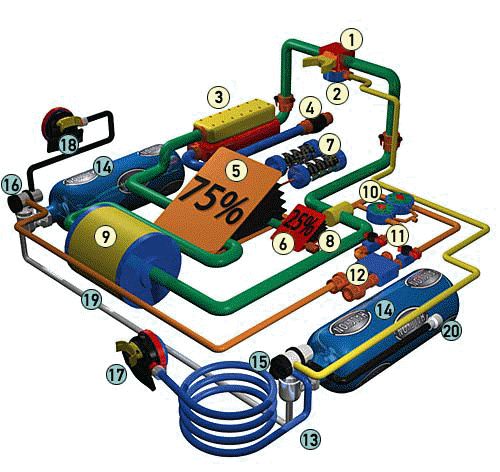 |
Theory: Market leader in the field of a regulated SCR is Halcyon. The Halcyon system uses the physiological ratio between breathing frequency and metabolic usage to establish the necessary flow for semi closed functioning. Linearity exists between the higher gas consumption at labour, increased breathing volume and the metabolic usage. Of every breath at the surface 3.85% is metabolically consumed. The volumetric proportion number is 1:26. Because the metabolic usage of a diver is not influenced by increased depth it remains constant *. So only the volumetric need directly proportional with depth is changed. This is the principle at which the technique is based on. The Halcyon and other regulated SCR rebreathers use a variable flow rate, related to the breathing volume. As soon as the diver exhales in the counter long both the inner and outer counter long are filled. At the inhalation, a part of the loop is dumped. The volumes of the inner and the outer counter lung define the amount of gas injected; their proportion is 1:26.
*almost, but will be influenced by labour. |
|
Practice: The operation of a passively regulated SCR rebreather is based on the respiratory minute volume (RMV). In other words, if you breathe the rebreather provides gas. This differs from the active (normal) systems like the Dolphin and the Ray, which supplement gas irrespective of whether someone is using the rebreather. Only supplying gas when a diver asks for it, saves an enormous quantity of gas. Probably you wonder how the rebreather is able to notify the moment a diver needs gas. As soon as the diver exhales, the gas flows into an exhalation lung which contains a second much smaller exhalation lung. As soon as the divers inhales an under pressure will arise in the large exhalation lung which squeezes together this inside located small lung. The small lung dumps the gas into water. At the surface this quantity of gas is 25% of the breathing volume. It is important moreover that this discharging takes place before it enters the CO2 scrubber so less gas flows through the scrubber and a higher output can be reached. Looking at the gas usage the PVR-BASC rebreather will now gain a proportion ~4:1 with regard to open circuit. This of course because by every breath only ~25% gas is drained into the water. As soon as the diver goes deeper and the pressure increases, the volume of the exhalation lung will be reduced by a pressure compensation system. Because of this also the volume of the drained gas will decrease linearly with the depth. The result is a larger volume in the inhalation lung. As the diver descends deeper this ratio will change until approx. 10 bar. At this depth the gas efficiency is about 40 times better then with OC!! The quantity of gas which is added mechanically corresponds with the quantity of gas which is dumped. A handle links the inhalation lungs with a supply valve. At every breath the handle rises and falls. As soon as the inhalation lung is drained the valve opens and gas is supplemented until the lung is full again. At the Halcyon rebreather the gas is added `upstream', at the last possible point before the inhalation. We call this `biased addition'. The location at which the gas is supplied is important because this makes it possible that the mixing of the gas takes place as late as possible. |
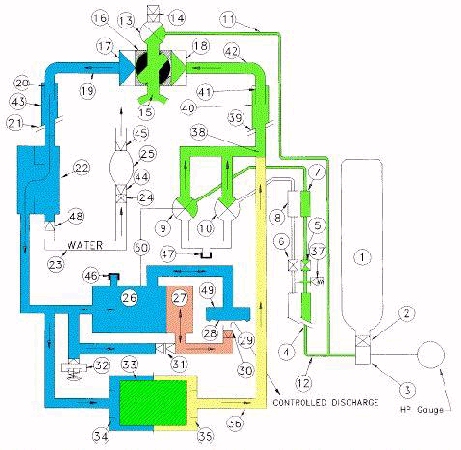 |
Dutch text: |
|
|
De geregelde semi-closed rebreather is een bijzondere rebreather. Een passive variable ratio-biased addition semi-closed (PVR-BASC) rebreather is ook een benaming voor dit type rebreather. Tot op heden zijn er slechts enkele ontwerpen. De grondlegger voor dit principe is waarschijnlijk de Rus Khotinsky die al in 1881 een systeem volgens het hier besproken principe produceerde. Veelal wordt de DC55 de vader van de passieve systemen genoemd, maar het valt te betwijfelen of dit juist is. Een zeer rechtlijnige uitleg over de werking van een passief werkende rebreather zou als volgt kunnen worden geformuleerd: In een gesloten kringloop wordt bij elke inademing een deel van het loopvolume naar buiten gedumpt, en bij elke uitademing een deel weer aangevuld. De werking berust op mechanica of hydrostatica. Door de dump en supply volumen af te stemmen op het metabolisme van de duiker kan een hoog rendement qua gas gebruik worden gerealiseerd. Op moment van dit schrijven is dit ontwerp
volop in belangstelling. De op dit moment verkochte modellen zijn vrijwel
allemaal gebaseerd op een regeling met kleppen die openen en sluiten op basis
van drukverschil. Er bestaan echter ook mechanische systemen waarvan
de alternating
closed and semiclosed system (ACSC) en het demand controlled semi-closed
system (DCSC) een voorbeeld zijn.
Het op dit moment in belangstelling staande systeem wordt o.a. door Halcyon op de markt gebracht. Bij het WKPP
project is
volop gebruik gemaakt van dit type rebreather. |
|
 |
Theorie: Marktleider op het gebied van geregelde SCR
is Halcyon. Het Halcyon systeem gebruikt de fysiologische ratio tussen
ademfrequentie en metabolisch verbruik om de noodzakelijke flow voor semi
gesloten werking in te stellen. Verhoogd gas gebruik bij arbeid, verhoogd
ademvolume en metabolisch verbruik zijn lineair met elkaar verbonden. Van
elke ademhaling aan de oppervlakte wordt 3,85% metabolisch verbruikt. Het volumetrisch verhoudingsgetal is hiermee 1:26. Omdat het metabolisch
verbruik van een duiker niet wordt beïnvloed door het vergroten van de
diepte blijft het constant*. Hierdoor verandert slechts de volumetrische behoefte
direct proportioneel met de diepte. Dit is de kern van de techniek. De Halcyon
en andere geregelde SCR rebreathers gebruiken een
variabele flow rate, gerelateerd aan het ademvolume. Zodra de duiker uitademt
in de contralong wordt zowel de binnenste als de buitenste
contralong gevuld. Bij de inademing nu, wordt een deel van de loop
gedumpt. De volumes van de binnenste en de buitenste long
bepalen de gasinjectie en verhouden zich als 1:26. |
|
Praktijk: |
 |
Examples of passive semiclosed rebreathers: |
|
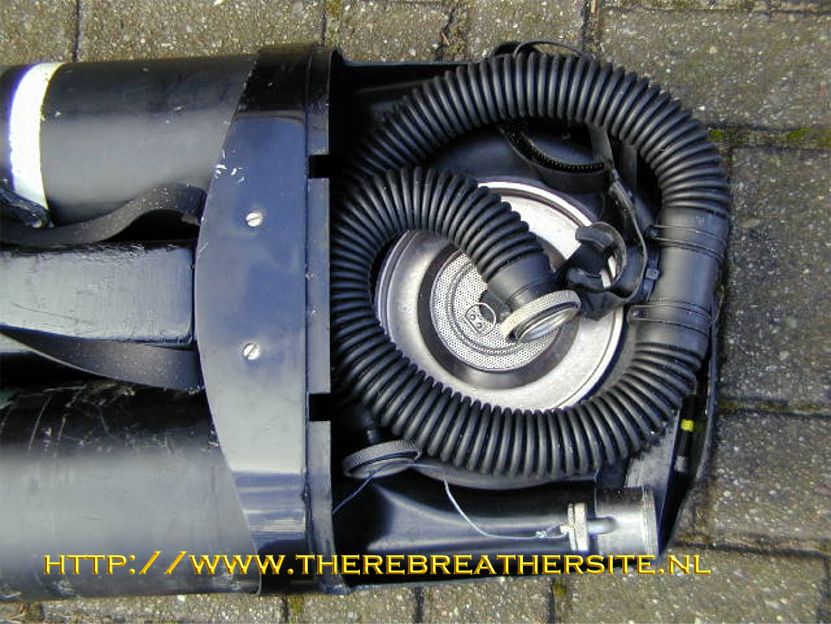 Mother of passive SCR : DC 55 |
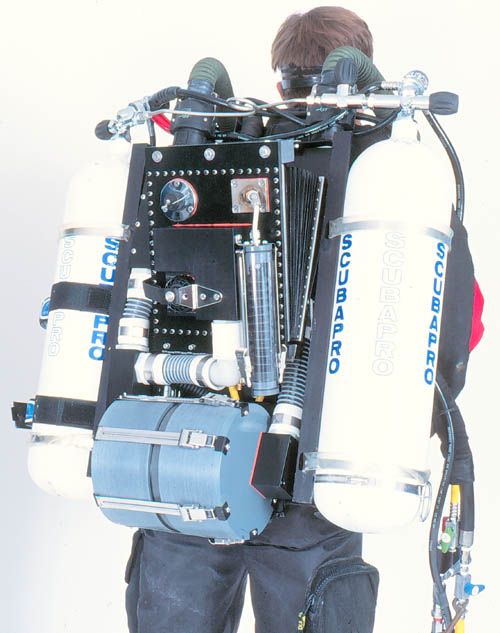 |
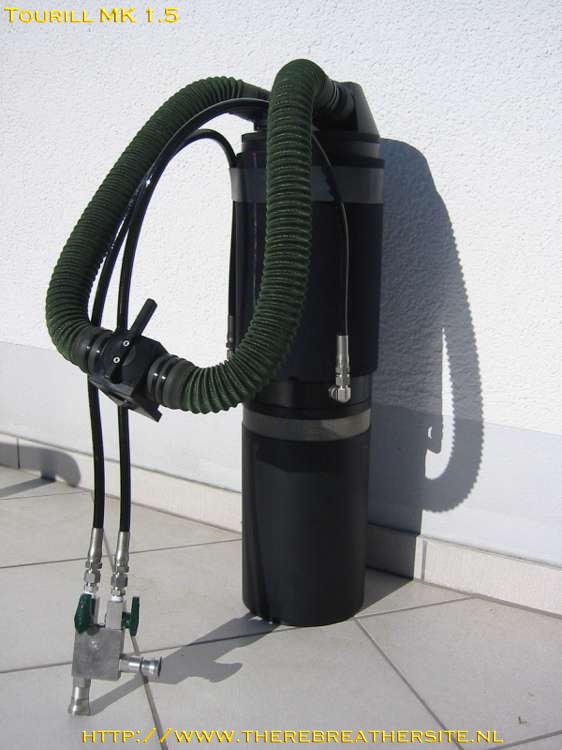 |
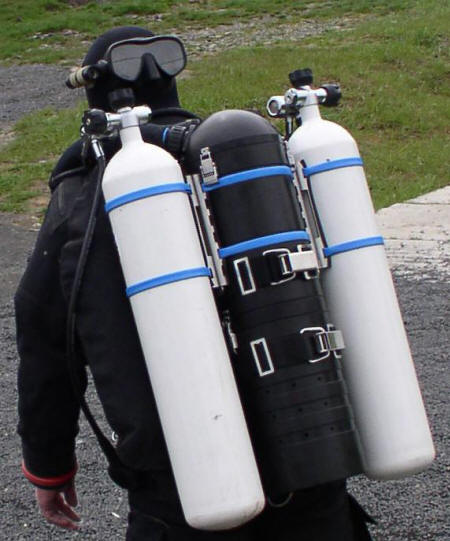 |